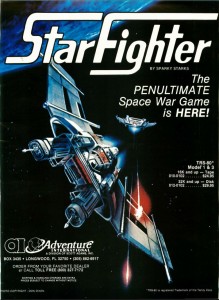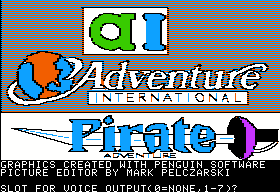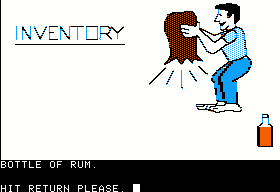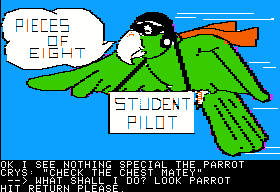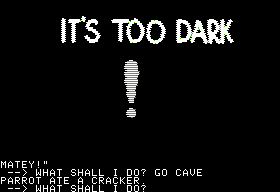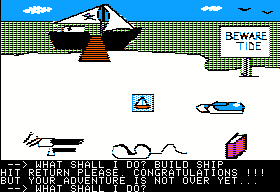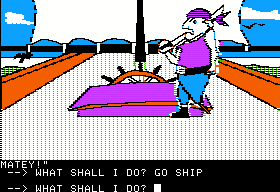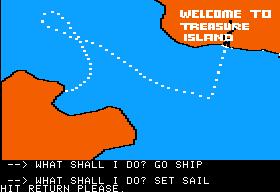I haven’t had much to say recently about Scott Adams, the man who first brought adventure games to PCs. But he was out there through all of the developments I’ve covered since the last time I wrote a post about him, continuing to run Adventure International and to slowly expand his stable of simple 16 K adventures. I called AI the Dollar General of the early software industry in that last post, and I don’t know how to express it any better today. It existed in a sort of hazy space between publisher and mail-order catalog retailer; many of its programs were also available in other ways thanks to non-exclusive publishing agreements, and most were available only via the catalogs or the company’s single Longwood, Florida storefront (“Just 40 minutes from DISNEY WORLD!”), never finding their way into shops. AI is perhaps best seen as a bridge between the very earliest days of microcomputer software, when semi-altruistic organizations like SoftSide magazine’s TRS-80 Software Exchange and Creative Computing‘s equivalent organ acted as mere middlemen to help programmers sell their creations, and the modern paradigm that had fallen pretty firmly into place by 1982, of software publishers that functioned like book or record publishers in demanding exclusive rights from the actual creators and aggressively marketing those creations under their own brand.
In the long run such a business model was going to be problematic for AI, as the new order asserted itself more and more. As of 1982, however, they were still doing well within their niche. Their catalogs remained the same ramshackle pile of junk, oddities, and the occasional gem, all priced much cheaper than the more polished products of the competition. Sometimes, when AI felt they had a particularly hot product on their hands, they would try to pierce their insularity and play with the On-Lines and Brøderbunds, yet without losing the same weirdly, um, casual approach to basic English diction that marked their catalogs and the adventures of their founder.
I don’t think “penultimate” means what you think it does, Mr. AI Copywriter. At moments like this there’s something almost lovable about AI’s happy slapdashery.
Space war games aside, AI’s flagship titles remained their adventure games. Despite being like Ken Williams and Doug Carlston in needing to spend more and more time running a company and less and less hacking, Scott Adams managed to author another of these in 1981, Savage Island Part 2, and also co-authored Golden Voyage with a university student named William Demas. This brought AI’s line of official Scott Adams games to the neat dozen that have passed into history as the original Scott Adams canon. By 1982 their OtherVentures line, a grab bag of games not authored by the master himself, consisted of an additional five titles of varying technical approaches and quality, among them yet another port of Crowther and Woods’s original Adventure and Lance Micklus’s landmark Dog Star Adventure. But now AI’s comfortable position was beginning to feel threatened by the innovations of other companies. To understand why, let’s step back for just a moment to survey the adventuring field as a whole.
There’s a simple narrative about the life and (commercial) death of the text adventure that most of you interested enough to read this blog probably know all too well already. In the beginning, it goes, adventure games were all text all the time. But then came Mystery House, and in the years that followed more and more makers began adding pictures to their games, which became more and more important, until finally they were all that was left. Throw in the requisite appreciation of Infocom and a few other holdouts who stayed with text until it was painfully obvious that that way lay madness, and that’s pretty much the story.
As simplified encapsulations go, the story is fine. Still, there are things that surprised me when I started to look closely at the actual timeline of releases. One of those was just how quickly games with graphics came to dominate the market in the wake of Mystery House and (especially) The Wizard and the Princess, at least on machines like the Apple II that had the ability to display reasonable pictures. A flood of other “hi-res adventures” followed On-Line’s into the market, so many that On-Line would eventually feel the need to start suing others for using what they saw as their own name for their own unique line of games. Already in its May 1982 issue Softline magazine wrote that “the demands of the market are weighted heavily toward hi-res graphics” in adventure games.
Put crudely, we might say that text-adventure makers sorted themselves into two groups: those who saw text as a necessary kludge only, and got away from it as quickly as possible (the vast majority); and those who defined themselves by a more literary sensibility of which the use of text was an essential part (largely only Infocom at this point, although a handful of others would spring up to follow their example). In other words, are you working with text because there’s no other choice given technological constraints, or out of an intrinsic fascination with the medium? Let’s call the former group Type 1; the latter Type 2. This dichotomy continues to persist today; those who continue to write and play textual interactive fiction out of a love of the form itself often confuse others who see text adventures only as an early, primitive form of gaming technology that was quickly and thankfully replaced with something better.
The big, obvious drawback of including graphics was that they used precious memory and disk space on machines that had little of either to spare. Still, most players were entranced enough by pictures that they were willing to accept the tradeoff of less or worse everything else: total text, total length, parser, world modeling, execution speed, etc. The Apple II commercial adventure market by 1982 was divided between the picture-sporting but otherwise very primitive “hi-res adventures” and, well, at this stage pretty much just Infocom, who offered no pictures but better and more of just about everything else. It would be another year or so before Infocom started aggressively marketing their lack of graphics as addition by subtraction, but already they were beginning to stand out from everyone else for their refusal to jump on the hi-res bandwagon.
The only company that didn’t fit comfortably into this bifurcation was Adventure International. The Scott Adams adventures were still built using the same technological blueprint Adams had developed way back in 1978, when his Adventureland became the first adventure game to reach microcomputers. They still had to fit, database and interpreter, into just 16 K of memory, meaning they combined the worst of both adventuring paradigms: the lack of pictures of Infocom and the primitive everything else of typical graphics games. Luckily, the games’ low system requirements made them ideal for a market virtually everyone else missed. In addition to comparatively powerful machines like the Apple II, Atari 400 and 800, and the new IBM PC, the computer industry of the early 1980s had a huge soft underbelly of cheap, low-powered machines like the TRS-80 Model 1 and 3, the TI-99/4A, and the king of this segment and bestselling computer in the world, the Commodore VIC-20. For these machines, the Scott Adams titles, with their need for only 16 K of memory and their ability to run off cassette or even (in the case of the VIC-20) cartridge, were literally the only adventure games in town. Adams had a captive market here, as uncontested as the general PC market had been back in 1978. For several years he fed very well upon it.
Yet it would be nice to compete on the bigger machines as well, wouldn’t it? To do that he would obviously need to improve his games, to bring them more in line with those of either On-Line or Infocom. Given the carelessness of the prose in his games, one might be tempted to immediately lump Adams in with On-Line as a Type 1 developer. Surprisingly, however, even in a 1984 interview he was still expressing ambivalence about the addition of graphics to adventure gaming: “I still do prefer text. The player is left to exercise his imagination and provide his own images, which is more exciting.” Still, it would be much easier to add graphics to his existing games, using the ample memory and disk space they left unused in a machine like the 48 K Apple II Plus, than to rewrite them from scratch with the better everything else of Infocom. And that was clearly the path of least commercial resistance. As he said in the same interview, “If we can provide graphics, and people want graphics, then we should let them have graphics.” The result was SAGA, the Scott Adams Graphic Adventures.
At the heart of each SAGA is the original non-graphic adventure’s data file. (Literally; even misspellings go uncorrected.) To this foundation AI’s long-term in-house artist, “Peppy,” added lots of bright, colorful illustrations, one for each location as well as the occasional bonus scene. Following On-Line’s lead, you can see the text “behind” a picture by hitting enter on an empty command line, and takeable objects show up in the pictures, lending them a certain degree of interactivity and functionality rather than serving strictly as decoration. However, there isn’t the persistent annoyance that dogs the On-Line games of always needing to wonder whether pieces of the illustrations not described in the text can nevertheless be interacted with. Because they are text adventures with hooks for graphics retrofitted after the fact, you can turn off the graphics entirely if you like without missing anything vital.
In preparation for writing this post, I played through the SAGA version of Pirate Adventure, Adams’s second game and the one, along with The Count and perhaps the original Adventureland, that is generally the most fondly remembered today. (In contrast to pretty much every other designer ever, Adams’s games tended to get less and less satisfying as his career progressed.) And indeed, Pirate Adventure, which was co-written by his wife of the time, Alexis Adams, shows Scott Adams with his best foot forward. This early in his career he did not yet feel the need to ratchet up the difficulty through increasingly absurd puzzles. Yes, there are still some parser frustrations as well as such Scott Adams-isms as UNLIGHT as the antonym of the verb LIGHT, but the central task of building a ship is fun, and there’s an enthusiastic, encouraging tone to the text (what there is of it) that makes the whole go down surprisingly easy even today, a remarkable feat for such an early, primitive effort. There’s even a smidge of the more dynamic storyworld that would appear in The Count, with a cracker-loving parrot and a rum-loving pirate who move about. The SAGA version, with lots of pictures that are perhaps not quite up with the best of On-Line but aren’t bad either, only adds to the charm — at least until the slowness of loading all those graphics from disk makes you opt for all-text mode again.
AI released SAGA versions of the first three of the Scott Adams dozen in 1982, followed by the next three the following year, while also continuing to market the text-only versions for low-end machines that couldn’t support the graphic versions. Some of the OtherVentures also got their graphical due. A changing market and changing priorities after that meant that the remaining titles never got converted.
In their time the SAGA games served their purpose of breathing new life into this stable of old, comparatively unsophisticated games. Sure, Adventure International continued to look a bit low rent in comparison to slicker publishers, but their games were relatively inexpensive and, at their best, fun. For plenty of eager adventurers who had exhausted the works of other publishers, or who lacked the machine or the money to access them, Scott Adams and his OtherVentures buddies still held plenty of appeal. They could even do one thing the competition couldn’t: they could talk. That is, when running on a computer with a Votrax Type ‘n Talk, the first hardware-based speech synthesizer to arrive for PCs. Sure, it was a gimmick, but it was a clever one, and one that probably sold some SAGAs on its own.
If you’d like to check out SAGA for yourself, here’s Pirate Adventure for the Apple II.
